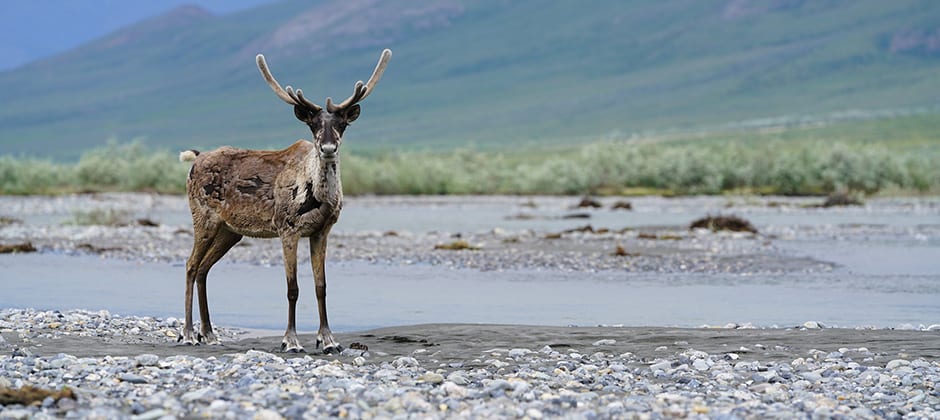Share this article
Indigenous observations track caribou through climate change
It started out as an international collaborative effort to track the potential effects of future oil and gas development on a large, migratory caribou population. But a decade worth of tracked observations in indigenous communities has revealed that the warming climate may be helping to bolster the Porcupine caribou herd in Alaska, Yukon and the Northwest Territories.
“That’s not to say that climate change won’t have negative impacts in the future, but for now it seems to be doing well,” said Catherine Gagnon, director of the Cabinet-Conseil Érébia, a consulting firm that specializes in relations with indigenous communities.
While interweaving Indigenous and Western knowledge offers benefits to ecological understanding, as highlighted in the cover story for the July/August issue of The Wildlife Professional, some research shows that indigenous knowledge is consistently undervalued when it comes time to make environmental decisions.
In analysis published recently in the Journal of Applied Ecology, researchers looked at data collected by the Arctic Borderlands Ecological Knowledge Society, (ABEKS), a community-based ecological monitoring program documenting ecosystem change in Yukon, the Northwest Territories and Alaska.
The society, which now includes indigenous community members; researchers; and provincial, state, federal and territorial governments, was formed in 1994 over fears about possible oil development in the Arctic National Wildlife Refuge in northeastern Alaska. Indigenous groups from Canada and the United States were concerned about the effects the oil and gas industry might have on the Porcupine barren-ground caribou herd (Rangifer tarandus granti), which passes between Alaska, Yukon and the Northwest Territories in its yearly migrations. The society began collecting observations of hunters and other community members about the size, and relatively body conditions of caribou in the herd starting in 1999.
“I don’t know of any project that has been going on so long within the indigenous community,” Gagnon said.
She worked with the society while finishing her PhD at the University of Quebec at Rimouski, combining data taken from the community observations collected by ABEKS with NASA satellite climate data. Gagnon and her co-authors, which include ABEKS researchers, overlaid community observation data from 617 individual caribou in the spring and 711 individuals in the fall on climate maps that had temperatures in different areas from 2000 to 2010.
While aerial surveys showed that the herd increased by 3.6% every year, the study found that caribou body conditions during spring and fall improved over the same decade.
The reason has to do with snow depth, which is shallower in warmer springs, reducing the energy costs of moving, Gagnon said.
“Less snow in spring is helping females to reach calving ground healthier and with more fat,” she said.
A 10-year study isn’t enough to draw long-term conclusions, though, Gagnon said, and the changing climate could ultimately result in negative consequences for the herd in the future — especially if female caribou arrive at calving grounds before vegetation begins to grow.
This kind of study is just the type of research that needs to be done, said Pamela McElwee, an associate professor in human ecology at Rutgers University who was not involved in Gagnon’s research. “If you want to have indigenous knowledge be a part of your assessment, you can’t just tack it on in the end,” she said. This type of long-term observation is an area of special expertise among indigenous communities, McElwee said.
In another study published recently in the Journal of Applied Ecology, McElwee and her co-authors assessed working with indigenous communities in a large-scale ecological assessment, the Intergovernmental Science‐Policy Platform on Biodiversity and Ecosystem Services, an organization of different governments around the world that regularly assesses the science on biodiversity.
McElwee said her team made sure from the beginning to interweave indigenous and local knowledge into the assessment, which found that a million animal and plant species around the world are threatened with extinction
“The people that are affected by science should take a role in the way that science is done,” McElwee said.
Her team found that indigenous knowledge improved the overall quality of the report. Indigenous people have a large stake in their local ecosystems, they concluded, and are very interested in monitoring long-term ecological change as a result, whether this means the climate change affecting caribou in the Arctic or the impacts of invasive species.
“Indigenous people have an incredibly important role to play in ecosystem management,” McElwee said.
But not all agencies or other groups conducting wildlife management seem to have gotten the message about the benefits of working together with indigenous communities.
A study published recently in People and Nature found that indigenous knowledge is underused and often misunderstood when it is applied to environmental decisions.
“Much of the research community has not made adequate space for Indigenous knowledge and continues to undermine its potential for information decision-making,” said Victoria Buschman in a press release. Buschman is an Inupiaq Inuit wildlife and conservation biologist at the University of Washington and a co-author of the study. “We must let go of the narrative that working with Indigenous knowledge is too challenging.”
Buschman and her international co-authors found that improving relationships between western scientists and indigenous groups requires equitable power relations, and that values, laws, institutions and funding can help improve these relationships.
Header Image: A caribou in the Arctic National Wildlife Refuge in Alaska. Credit: Danielle Brigida








